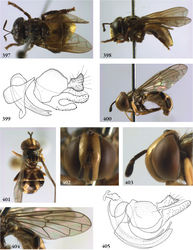Surimyia
| Notice: | This page is derived from the original publication listed below, whose author(s) should always be credited. Further contributors may edit and improve the content of this page and, consequently, need to be credited as well (see page history). Any assessment of factual correctness requires a careful review of the original article as well as of subsequent contributions.
If you are uncertain whether your planned contribution is correct or not, we suggest that you use the associated discussion page instead of editing the page directly. This page should be cited as follows (rationale):
Citation formats to copy and paste
BibTeX: @article{Reemer2013ZooKeys288, RIS/ Endnote: TY - JOUR Wikipedia/ Citizendium: <ref name="Reemer2013ZooKeys288">{{Citation See also the citation download page at the journal. |
Ordo: Diptera
Familia: Syrphidae
Name
Surimyia Reemer – Wikispecies link – Pensoft Profile
- Surimyia Reemer, 2008: 179. Type species: Surimyia rolanderi Reemer, 2008: 180, by original designation.
Description
Body length: 4–5 mm. Small flies with short antennae and oval abdomen. Head slightly wider than thorax. Face convex; narrower than an eye. Lateral oral margins not produced. Vertex flat. Occiput ventrally narrow, dorsally widened. Eye bare. Eye margins in male not converging at level of frons, with mutual distance about 3 times as large as width of antennal fossa. Antennal fossa about as wide as high. Antenna shorter than distance between antennal fossa and anterior oral margin; basoflagellomere shorter to longer than scape, oval, about twice as long as wide, bare. Postpronotum bare. Scutellum semicircular; without calcars. Anepisternum convex; dorsally with thick, setae-like pile, ventrally bare. Anepimeron dorsally with thick, setae-like pile, ventrally bare. Katepimeron convex; bare. Wing: vein R4+5 without posterior appendix; vein M1 straight, perpendicular to vein R4+5; postero-apical corner of cell r4+5 rectangular, with or without small appendix; crossvein r-m located very close to base of cell dm. Abdomen oval, about 1.5 times as long as wide. Tergites 3 and 4 fused. Sternite 1 bare. Male genitalia: phallus furcate, with furcation point about halfway, curved dorsad, straight, projecting not or slightly beyond apex of hypandrium; hypandrium without bulb-like base; epandrium without ventrolateral ridge; surstylus unfurcate.
Diagnosis
Abdomen oval; yellow and black. Vein R4+5 without posterior appendix. Postpronotum bare. Antenna shorter than distance between antennal fossa and anterior oral margin.
Discussion
Reemer (2008)[1] included in his new genus Surimyia a species previously assigned to Paragodon (Paragodon minutula van Doesburg, 1966). Several morphological characters were mentioned to indicate the differences between these genera (Reemer 2008[1]). Especially the structure of the phallus seems fundamentally different: short, straight and unfurcate in Paragodon, and long, curved and bifurcate in Surimyia. Other distinctive differences are the bare postpronotum in Surimyia (pilose in Paragodon) and the bare anatergum in Surimyia (microtrichose in Paragodon).
Diversity and distribution
Described species: 2. Neotropical (presently only known from Surinam).
Syrphipogon Hull (subgenus, see Microdon)
Taxon Treatment
- Reemer, M; Ståhls, G; 2013: Generic revision and species classification of the Microdontinae (Diptera, Syrphidae) ZooKeys, 288: 1-213. doi
Other References
- ↑ 1.0 1.1 Reemer M (2008) Surimyia, a new genus of Microdontinae, with notes on Paragodon Thompson, 1969 (Diptera, Syrphidae). Zoölogische Mededelingen 82: 177-188.
Images
|
